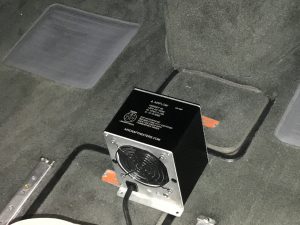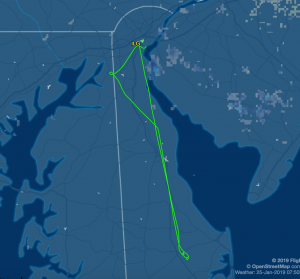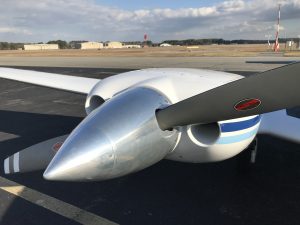Report on the new Twin Hornet pre-heat system before the latest test flight is positive.
Weather over the last three days has gone from bitter cold low 20’s to mid 40’s yesterday to mid 30’s today. The wind has been howling everyday, and today was gusting 26 knots. Inside the hangar I found all three heaters to be ON, the Nacelles warm to the touch, and the cabin comfortably warm. That is a good first sign – no heat stress on anything.
I took my time developing a flow or process for taking the heaters out for a flight and storing them off to the side. Pull the extension cord plug that is powers all three heaters; remove, fold, and store the blankets; and remove the cowl plugs and pitot cover and store those as usual. Then I pull out the new Twin Hornet 22 heaters from the nacelles and walk them to the buckets holding the left and right blankets. I need to be careful not to drop them, so I resist the temptation to lay them on the nacelles for a moment.

I open the door to get the Twin Hornet 45 that sits on the floor and move it back to the baggage area. It is difficult to get a certain grip on it, and will be improved if it had a plastic handle on the top.
I get out of the airplane and close the door, walking around to the baggage area from the outside. I take out the heater and put it out of the way on the floor. Again I am cautious not to leave it on the shelf in the hangar, worrying that tripping on the cord will send it crashing to the floor. Just a few minutes of care will keep these from being damaged. This little cube needs a handle.
I hooked up the PowerTow and towed the airplane out of the hangar. Very cool how smoothly it started and how great the adjustments I made were.
With the airplane outside, I left the cowl flaps closed for now and chocked the airplane. Put the tow away and close up the hangar while my motors cool in the gusting winds. I can’t worry about that and won’t rush.
With my car in the hangar and the door closed up, I climbed into the cabin and found warm and comfortable still. Master switch on, both oil gauges indicated on the low end of the scale. Any indication means the oil is heated, so I’m comfortable that I’m better off than without pre-heat.
I push up the mixture for the left engine and see a most definite improvement in it’s movement. The pre-heat has made this cable, which I acknowledge is binding and needs replacement, much easier to move. It isn’t binding! I’m not sure if the nacelle heat made the difference, or the cabin heat. One of them most certainly made this issue easier to deal with until I get the cable replaced.
It was difficult to tell from my non-scientific testing if the starting was improved any. Both cold starts and hot starts fire right up. What I did notice is the oil pressure reached normal levels more quickly, and never went very high at all. Remember that the right engine has 100W mineral oil for the new cylinder, and cold pressures get pretty high. I think the heaters are doing a great job and I’m glad I bought them at this point!
 I take off from runway 32 and do a climbing left turn toward Georgetown. The winds were howling and the ride was rough, but the autopilot performed flawlessly.
I take off from runway 32 and do a climbing left turn toward Georgetown. The winds were howling and the ride was rough, but the autopilot performed flawlessly.
Is that because it’s warm, or because I have been exercising it over several of these test flights? I have no idea, butI can tell you that the airplane had bugs when I flew it the first time, and those bugs drop off one at a time and the airplane flies.
It was very nice to see the airplane perform so well today, as I reach 10.4 total hours since the Jan 6th return to flight. Only 4.6 more hours and I’ll schedule time with Matt for the 15 hour check.
 I love the airplane and I absolutely love the hangar setup with pre-heat. As I stood there admiring it all, I couldn’t help but see how badly my spinners need polishing! As soon as it gets warm, I’ll spend a wonderful day to that one at a time.
I love the airplane and I absolutely love the hangar setup with pre-heat. As I stood there admiring it all, I couldn’t help but see how badly my spinners need polishing! As soon as it gets warm, I’ll spend a wonderful day to that one at a time.
Oh – I made another VFR mistake like a rookie. I turned downwind to taxiway Bravo instead of runway 28 at Delaware Coastal (Georgetown). I announced turning final on 28 and the heading indicator wasn’t near 28. The picture out the window confirmed I was an idiot, going around to try again. At least it was solid go-around practice and I did it right the second time. Dufus!
The flight home was bumpy, but uneventful I even flew a circuit around my house before heading back to the barn.
I am planning to fly tomorrow, but am not sure in what direction. I may do a few approaches, since I haven’t done one in this airplane in a very long time. The Autopilot works 100% and I can’t wait to try it.
Fly Safe!!
Frank
